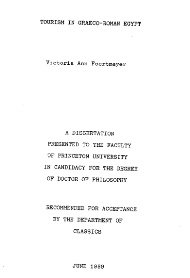| Main » Ad Board » ДРЕВЕН ЕГИПЕТ И АФРИКА » Бит и ежедневие |
Victoria Ann Foertmeyer - Tourism in Graeco-Roman Egypt
| 16.07.2017, 07:59 | |
Тази дисертация разглежда един слабо изучен аспект на египтологията, а именно туристическите практики в Египет през гръко-римската епоха. Посочени са основните причини за тези пътешествия: жаждата за екзотика, търсенето на "чудеса" и "древна мъдрост", поклонническите пътувания до древни култови центрове като светилищата на Озирис и Изида, храма на Амон в оазиса Сива и др. Подложени на анализ са графитите, оставени от пътуващите, както и различните им социални категории.
- на английски език, от Google Docs,формат PDF, файлът не е архивиран. Сваляне с ляв бутон (downloading by left button) от страницата на предоставящия сървър, после през бутона стрелка надолу/after by down arrow button.
| |
| Views: 1135 | Placed till: 16.08.2022 | Rating: 0.0/0 | |

